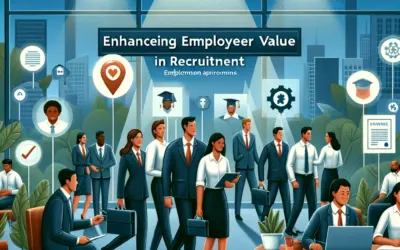Understanding Branding Excellence: The Importance of a Strong Employer Brand
In today’s competitive market, branding excellence is not just about the products or services a company offers. It extends to the very core of the company’s values and how it’s perceived not only by consumers but also by current and potential employees. A strong employer brand is paramount in attracting and retaining top talent, which in turn, propels a business towards success.
How a Strong Employer Brand Attracts Top Talent
Job seekers are drawn to companies that offer more than just a paycheck. They are looking for organizations where they feel their work is meaningful and their values align with the company’s mission. A significant employer brand communicates a company’s culture, its commitment to employee development, and the potential for career growth. By presenting a clear and appealing employer value proposition, companies are more likely to attract the best candidates in the field.
The Role of Employer Branding in Employee Retention
Employee retention is as critical as the initial attraction of new talent. A strong employer brand instills a sense of pride and loyalty among employees. It creates a work environment where employees feel respected, valued, and integral to the company’s mission. Investing in employer branding strategies can thus lead to increased employee morale and lower turnover rates, which are key to maintaining a competitive edge in your industry.
Best Practices for Cultivating a Strong Employer Brand
Building an employer brand doesn’t happen overnight. It involves a strategic approach that includes regular communication of the company’s vision, successes, and challenges. Encouraging employee advocacy and storytelling can also enhance the authenticity of your brand. Additionally, maintaining a presence on career sites and social media, where potential and current employees engage, is vital for showcasing your company’s culture and employer brand.
- Create a clear employer value proposition.
- Communicate company’s culture, mission, and values effectively.
- Foster employee growth and development opportunities.
- Encourage employee advocacy and storytelling.
- Maintain an active and engaging presence on career-oriented platforms.
Creating a Compelling Employer Value Proposition
Understanding the Basics of an Employer Value Proposition
An Employer Value Proposition (EVP) is a critical framework that defines the unique set of benefits and values an organization promises to deliver to its employees. Essentially, it encapsulates the essence of your brand as an employer and underlines what you stand for. A compelling EVP should clearly articulate the key reasons a potential employee would find your company an attractive place to work, aside from the paycheck. These facets typically include culture, opportunities for growth, the kind of work being done, and the recognition and benefits provided.
Identify Your Unique Selling Points
Crafting an EVP starts with identifying the unique selling points of your company’s employment experience. You need to understand what sets you apart from competitors in the talent marketplace. Is it your innovative culture, your commitment to employee development, or perhaps your flexible working arrangements? Convey these unique attributes clearly and concisely.
Engage with Current Employees
Insight from current employees is invaluable when formulating an EVP. They can provide authentic perspectives on what it’s really like to work for your company. Utilize surveys, focus groups, and one-on-one interviews to gather in-depth knowledge of your existing employer strengths and areas needing improvement. This feedback not only helps in building an EVP but also signals to employees that their views are valued, thereby boosting morale.
Developing and Communicating Your EVP
The development of an EVP should be a strategic process involving leadership and key stakeholders. Once distilled, the EVP must be embedded into every aspect of the employee lifecycle, from recruitment to retirement. Leaders and HR professionals should embody the values of the EVP in their daily interactions, ensuring that the promise made is the reality experienced by employees.
Incorporating EVP into Recruitment Materials
The first touchpoint for many candidates is your recruitment materials, which makes it vital that these documents reflect your EVP. Job descriptions, career pages, and social media posts need to resonate with the details of the EVP, highlighting attributes that align with the interests and aspirations of the talent you wish to attract.
Training Your Team
Once you have a strong EVP, it’s essential to train your team to communicate and uphold it effectively. Leaders and managers should exemplify the values promised, acting as brand ambassadors for the company. Consistency in words and actions reinforces the reliability and attractiveness of your employer brand.
Measuring the Impact of Your EVP
Implementing a winning EVP is not a set-it-and-forget-it strategy. Regular measurement and fine-tuning are important to ensure it remains relevant and compelling. Key performance indicators (KPIs) should be identified for tracking the impact of your EVP, such as employee engagement scores, retention rates, and the quality of new hires.
Survey for Continuous Improvement
Constructive feedback is necessary to refine your EVP continuously. Regular employee surveys can help gauge how well the company’s values are being perceived and lived up to by management. This can identify areas that need attention, enabling HR to make informed decisions and to adapt the EVP to match changing circumstances in the company or industry.
Analyzing Recruitment Success
Another critical measure is analyzing recruitment metrics. Are you attracting and retaining top talent in your industry? If the talent acquisition costs have gone down while the quality of applicants has gone up, it’s a good sign that your EVP is making an impact.
Ultimately, a compelling Employer Value Proposition is more than just a static statement; it’s a dynamic and integral part of your organization. It’s reflected in the everyday experiences of your employees and the stories they share. As the workplace continues to evolve, so too should your EVP, always remaining a true reflection of the workplace culture and opportunities your company proudly offers.
Innovative Strategies to Showcase Your Employer Brand
Developing a Compelling Employer Value Proposition
Your employer brand is a reflection of your company’s identity and the promises you make to your employees. To communicate this effectively, it is essential to develop a compelling Employer Value Proposition (EVP). This statement should encapsulate the essence of your company culture, values, and the benefits of working for your organization. Once established, infusing your EVP across all communication platforms will provide a consistent message to potential candidates.
Embracing Social Media Storytelling
In the digital age, using social media to tell your company’s story can have a profound impact. Platforms like LinkedIn, Twitter, and Instagram offer a multimedia approach to showcase your company’s culture, community involvement, and employee successes. Regular posts celebrating employee achievements, office events, or community service initiatives add authenticity to your brand, drawing in prospects who want to be part of your unique story.
Employee Advocacy and Testimonials
One of the most effective methods to highlight your employer brand is through your current employees. Encouraging employee advocacy can exponentially increase your reach and lend credibility to your brand image. Create opportunities for employees to share their experiences, perhaps through a blog or video testimonials. When potential candidates see real stories from current staff, it humanizes your brand and makes it more relatable.
Investing in Career Development and Education
Potential employees are not just looking for a job, they are looking for an opportunity to grow. By investing in career development and education for employees, you send a clear message that you value their futures. Highlighting programs such as tuition reimbursement, online courses, and mentorship opportunities can make your employer brand stand out as one that invests in its people.
Remember, the strength of your employer brand lies in its authenticity and consistency. By implementing these strategies, you’ll not only attract top talent but retain it by ensuring your work environment reflects the values of your EVP. Start showcasing the uniqueness of your company, and watch your employer brand flourish.
Measuring the Impact of Your Employer Branding Efforts
Understanding Employer Branding Metrics
Employer branding is a critical aspect of any company’s talent attraction and retention strategy.
Measuring the effectiveness of your employer branding efforts is key to understanding its impact on
your organizational growth. Key metrics to track include your employer brand awareness, which can be
gauged through surveys and social monitoring, and the employee net promoter score (eNPS), which looks at the willingness of
your employees to recommend your company as a great place to work.
Other quantifiable aspects include engagement rates on social media, job offer acceptance rates,
and the quality of hire, reflecting the caliber of applicants you attract. Moreover, a reduction
in hiring costs and time-to-hire can indicate a strong employer brand that attracts top talent easily.
Surveying Brand Perception Internally and Externally
Regularly conducted, anonymized employee surveys provide a direct insight into internal brand perception.
This can be complemented with exit interviews to understand any gaps between the perceived and the actual employer brand.
Externally, tools like Google Analytics and social listening platforms offer invaluable data on how your brand is viewed
by potential candidates and the industry at large, based on interactions and search behaviors.
Analyzing Recruitment Marketing Data
Social Media Impact
Social media platforms provide realtime feedback on your employer branding content. Examining metrics such as likes, shares,
comments, and reach can give an immediate pulse on your brand’s market positioning. The interactions on platforms like
LinkedIn or Glassdoor are particularly relevant for employer branding and can also lead to insights into the areas of improvement.
Candidate Journey Analytics
A deeper dive into your recruitment marketing data can reveal how candidates interact with your brand throughout their job-seeking
journey. Visit Google Analytics to monitor behavior flows and bounce rates on career pages, which can suggest how
captivating your employer value proposition is. The application completion rates are a direct reflection of the candidate’s
engagement level and your brand’s effectiveness in communicating job benefits and culture.
Tracking Long-term Outcomes on Retention and Culture
The true impact of employer branding is often seen over the long term. Regularly monitor employee turnover rates and
retention statistics, as a strong employer brand should correlate with higher retention. Additionally, benchmarking these
numbers against industry standards can position your brand strength accurately.
Cultural impact, a more subjective measure, can be assessed by observing cultural alignment through employee behaviors and
satisfaction ratings. Here, employee engagement surveys and performance reviews serve as tools for capturing the adherence
to core values and overall satisfaction, inherent indicators of a resonating employer brand.
Case Studies: Companies that Excel in Employer Branding
Employer branding is the process of promoting a company as the employer of choice to a desired target group. A compelling employer brand not only attracts top talent but also retains current employees. Many companies have leveraged employer branding expertly to position themselves at the forefront of the job market. This blog post highlights case studies of companies that serve as benchmarks in employer branding.
Google: Innovation and Culture at the Core
Google stands out as a paragon of employer branding, consistently ranking at the top of ‘best places to work’ lists. The tech giant fosters an innovative culture, offering employees benefits like flexibility, wellness programs, and personal development opportunities. Google’s offices are designed to encourage creativity and collaboration, often featuring open spaces and recreational facilities. They manage to intertwine work-life balance within their brand image, making it highly attractive for potential candidates.
Salesforce: Prioritizing Employee Well-being
Salesforce’s reputation as a leader in employer branding arose from its dedication to employee well-being and equality. They offer a comprehensive benefits package that includes health, financial, and educational aspects, ensuring their workforce is well taken care of. Salesforce also places a strong emphasis on community engagement and corporate philanthropy, enriching their employer brand. Their commitment to equality and social impact is a driving force in attracting individuals who share similar values.
L’Oréal: Embracing Diversity and Professional Growth
L’Oréal, a global leader in cosmetics, has built an employer brand around diversity, entrepreneurial spirit, and professional growth. Their management trainee programs are designed to give employees a sense of ownership and the ability to drive their career paths forward. L’Oréal places importance on recognising and rewarding talent, thereby cementing its status as a desirable employer. Moreover, their commitment to sustainability and ethics enhances their employer brand image among environmentally-conscious candidates.
Exceptional employer branding isn’t exclusive to large corporations. All companies, regardless of size, can learn from these case studies and apply best practices to boost their reputation as employers. Focusing on unique culture, employee welfare, diversity, and corporate social responsibility can significantly enhance an organization’s appeal to potential employees.













0 comentarios